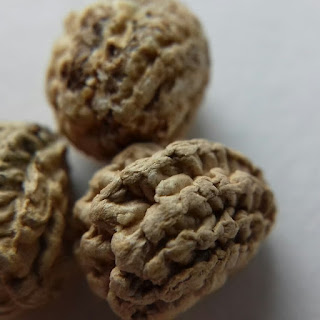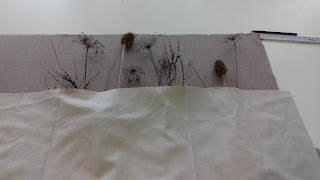Well it's Sunday afternoon, so I just about managed to sneak in my weekly blog post! Quite a lot has happened this week, so I've not managed to find the time to update you all with my progress, so here goes.
Firstly, my idea developed somewhat since my last couple of posts, and I have updated my official proposal accordingly. Most remains the same, but the title will be "Encapsulation, Dispersal and Putting Down Roots" and the work I create will be a metaphor for human migration. In addition to my previous posts, I will also be researching the human parallels.
For example, for encapsulation I will look at how the seed is formed, how the parent plant encapsulates it within a seed pod while it is forming & how this disintegrates to allow the seeds to disperse. How resilient the individual seed casings need to be to protect the precious life form inside, the layers of protection and how it softens to allow the seedling to emerge. For the human parallel I will look at pregnancy and the encapsulation of the foetus in the womb, and the protection of the family unit, the village, the community through childhood.
For dispersal I will look at the multitude of ways seeds disperse and the reasons - from apple seeds which don't travel far as they need at least 2 other trees nearby to cross-polinate in order to produce fruit, invasive species that if left unchecked will take over whole eco systems, plants that disperse their seeds by wind to travel a short distance, those that make their seeds attractive to birds so that they will be eaten but not destroyed by the digestive process and dispersed many miles, to those that disperse their seeds to be carried away by the ocean to find a place to grow anywhere in the world. For the human parallel I will look at methods of and reasons for human migration through history - from the nomadic lifestyle before farming was introduced, looking for more fertile lands, invasive peoples such as the Vikings and Romans, groups of people escaping from war en masse and individuals escaping personal situations. walking short distances and travelling to the other side of the world.
For Putting down roots I will look at the need to find the right environment in which to grow - the right soil conditions, light, water, heat, enough space. Not many seeds will thrive in the mountains or desert, yet some have adapted to do so. The same can be said for humans - we need fertile lands, a temperate climate and in current times a thriving economy in the region is becoming more and more necessary.
I have a lot of research to do, and have set dates in my diary to do so - I am off to Kew Gardens tomorrow and on Thursday will be heading to the V&A and the Natural History Museum, but in the meantime I have been taking photo's, sketching and experimenting with idea's. Here are some photographs I have been taking of seeds and seed heads that I have either purchased or found in my garden :
 |
| Nasturtium seeds |
 |
| Hollyhock seed head |
 |
| Honesty seed head |
 |
| Runner beans, dwarf french beans and peas |
 |
| Runner beans and dwarf french beans |
 |
| Beetroot seed |
 |
| Runner Bean seed |
 |
| Honesty seed head |
 |
| Hollyhock seed head |
 |
| Beetroot seeds |
 |
| Beetroot seed |
 |
| Runner Bean seed |
 |
| Hollyhock seed head |
 |
| Honesty seed head |
 |
| Honesty seed heads and seeds |
 |
| Runner Bean seeds |
 |
| Honesty seeds |
 |
| Hollyhock seeds |
 |
| Honesty seed under microscope (poor quality cheap one!) |
 |
| Honesty seed |
 |
| Runner Ban, Dwarf French Bean & Pea seeds |
 |
| Honesty seed under microscope (poor quality cheap one!) |
 |
| Physalis seed head |
 |
| Physalis seed head |
 |
| Seed head from garden, but not sure what species |
 |
| Seed head from garden but not sure of species |
 |
| Ammi Major seed head |
 |
| Lysimachia seed head |
 |
| Shasta Daisy seed head & seeds |
 |
| Stock seed head |
 |
| Stock seeds |
From these I have been sketching, drawing with ink and bleach and I have started a cardboard sculpture:
This is the first page in my sketchbook - my mindmap. I loved the transparent wax-paper like casings of the honesty seed heads, so I did a watercolour painting using masking fluid to keep the reflective surfaces of the outer seed casing pure white. I then applied washes, building up the layers of burnt umber to show where the seeds were inside the cases. I like the sepia feel from just using burnt umber and the aged effect that it gives, so I thought I would make the page look like an old, creased piece of paper that has been folded up in a drawer for a century. I also used typography that would be used in botanical illustration or on scientific specimens.



These are ink and bleach sketches of the Physalis (cape gooseberry) seed heads in my polytunnel. I experimented with ink and bleach in stage 2 and had started to get interesting results with washes of watered down inks and water sprays. I decided to try to push this further by creating an abstracted background using the techniques I had been experimenting with, then scratching the intricate tracery of the seed head in bleach with a cocktail stick. The result is luminous - the bleach seems to fluoresce out of the paper, which ties in beautifully with the common name for the seed heads - lanterns.





I have started a cardboard sculpture of a Hollyhock seed head. My intention was to make each individual seed, link them together in the round and then wrap them in the seed casing, however it took me a lot longer to make a single seed than I had expected! All of the intricate scalpel work would also be hidden, so it would be a waste of precious time. As such, I will proceed by making the rest of the round in a concertina format, and place the detailed sides either end, so it looks like a seed or 2 have dispersed and these are the two that will go next. Hopefully I will have this finished by the end of the week so I can show you what I mean more clearly!
Finally for this week, I have taken lots of photographs of some slides of root cross sections under a microscope. We bought a cheap digital microscope from the internet, which really didn't wok too well, so we sent it back and I approached Rhiannon in the science department at college to see if I could use one of their high quality ones.
Rhiannon was so helpful - not only will I be able to use the binocular microscope next week to look at the seeds (once the software has been installed on the art room computer), but she provided me with a normal microscope and some slides of cross sections of roots of Ranunculus, something beginning with V that I can't remember the name of but will find out on Wednesday & Helianthus. (you need a binocular microscope as the seeds are 3d - a normal microscope with a single lens will only focus on a tiny part of the surface and should only really be used for 2d images, slides & cross sections). Here are a few of the photo's I took from the root slides under the microscope at 4x, 10x and 40x magnification:










I want to recreate these patterns using knit and crochet in the round, then make a root system-like structure made of the threads hanging from the bottom of the round so you can see both what you would see with the naked eye and what it looks like magnified at the same time in the same textile sculpture.
I have also completed my 1,500 word proposal, joined the National Art Library ready to take a closer look at some original artists books and borrowed a LOT of technical books on felting, origami, paper textiles and folding architecture to learn some new techniques!
Told you I'd had a busy week! Right, time for bed so I can be up early for my visit to Kew Gardens tomorrow! Goodnight!




















































Comments
Post a Comment